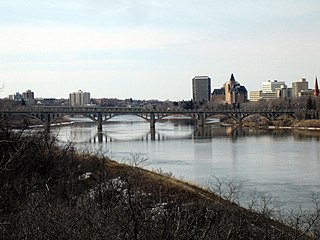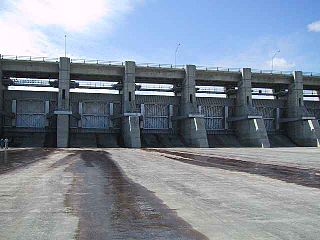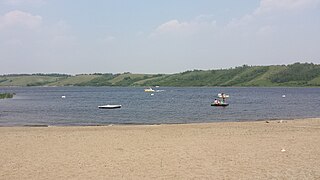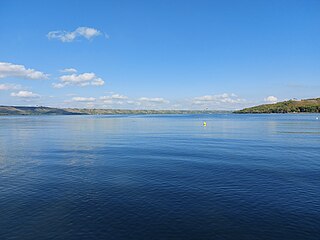
The South Saskatchewan River is a major river in the Canadian provinces of Alberta and Saskatchewan. The river begins at the confluence of the Bow and Oldman Rivers in southern Alberta and ends at the Saskatchewan River Forks in central Saskatchewan. The Saskatchewan River Forks is the confluence of the South and North Saskatchewan Rivers and is the beginning of the Saskatchewan River.

The Gardiner Dam on the South Saskatchewan River in Saskatchewan is the third largest embankment dam in Canada and one of the largest embankment dams in the world. Construction on Gardiner Dam and the smaller Qu'Appelle River Dam was started in 1959 and completed in 1967, creating Lake Diefenbaker upstream and diverting a considerable portion of the South Saskatchewan's flow into the Qu'Appelle River. The dam rises 64 metres (209 feet) in height, is almost 5 km (3.1 mi) long and has a width of 1.5 km (0.93 mi) at its base with a volume of 65,000,000 cubic meters. The dam is owned and operated by the Saskatchewan Water Security Agency.

The Qu'appelle River Dam is the smaller of two embankment dams along the South Saskatchewan River that created Lake Diefenbaker in the Canadian province of Saskatchewan. The bigger of the two dams is Gardiner Dam, which is the largest embankment dam in Canada and one of the largest in the world. Construction of both dams began in 1959 and was completed in 1967. Lake Diefenbaker is the largest lake in southern Saskatchewan.

Lake Diefenbaker is a reservoir and bifurcation lake in southern part of the Canadian province of Saskatchewan. It was formed by the construction of Gardiner Dam and the Qu'Appelle River Dam across the South Saskatchewan and Qu'Appelle Rivers respectively. Construction began in 1959 and the lake was filled in 1967. The lake is 225 kilometres (140 mi) long with approximately 800 kilometres (500 mi) of shoreline. It has a maximum depth of 66 metres (217 ft), while the water levels regularly fluctuate 3–9 metres (9–27 feet) each year. The flow of the two rivers is now regulated with a considerable portion of the South Saskatchewan diverted into the Qu'Appelle. Prior to the dams' construction, high water levels in the South Saskatchewan would frequently cause dangerous ice conditions downstream in Saskatoon while the Qu'Appelle would frequently dry up in the summer months.

The Rural Municipality of Blucher No. 343 is a rural municipality (RM) in the Canadian province of Saskatchewan within Census Division No. 11 and SARM Division No. 5. It is located in the north-central portion of the province on the South Saskatchewan River.

The Grant Devine Dam, formerly Alameda Dam, is an embankment dam located in the Canadian province of Saskatchewan near Alameda and Oxbow. It was constructed in 1994 to control flows on Moose Mountain Creek and Souris River. It provides flood protection and irrigation for this area of Saskatchewan, along with protection for Minot, North Dakota. The Grant Devine Reservoir provides opportunities for recreational use such as boating and fishing. At the full supply level of 562 metres (1,844 ft), the reservoir holds 105,000,000 m3 (3.7×109 cu ft) of water. The project is owned and operated by the Saskatchewan Water Security Agency (formerly Saskatchewan Watershed Authority).

Lac la Ronge is a glacial lake in the Canadian province of Saskatchewan. It is the fifth largest lake in the province and is approximately 250 kilometres (160 mi) north of Prince Albert, on the edge of the Canadian Shield. La Ronge, Air Ronge, and the Lac La Ronge First Nation are on the western shore. The lake is a popular vacation spot. Recreational activities include fishing, boating, canoeing, hiking, and camping.

Blackstrap Lake is a man-made reservoir in central Saskatchewan, Canada, south of Saskatoon in the Rural Municipality of Dundurn No. 314. The lake was created as a reservoir in 1967, as part of the Saskatoon South East Water Supply System. Blackstrap Lake has an area of 1,200 ha and is generally used to support irrigation, and the industrial and municipal water supply.
Indi Lake is a man-made lake in central Saskatchewan, Canada, south of Saskatoon in the Rural Municipality of Dundurn No. 314. The lake was created for irrigation and recreation in 1967 by a dam located at its south end. The lake is part of a greater irrigation and aqueduct system built in the 1960s in Saskatchewan and was named after Indi, an unincorporated railway point nearby on the Canadian National Railway (CNR).

McDonald Lake, also known as Rafferty Reservoir, is a reservoir in the south-eastern part of the Canadian province of Saskatchewan. It was created when the Rafferty Dam was built on the Souris River in 1994. Before the dam was built that flooded the Souris Valley, McDonald Lake was a small lake and marsh on the valley floor adjacent to the Souris River.

Moosomin Lake, also known as Moosomin Reservoir, is a man-made lake in south-eastern part of the Canadian province of Saskatchewan. Created by the damming of Pipestone Creek in 1954, Moosomin Lake is located about 10 kilometres (6.2 mi) south of the town of Moosomin and is in the Souris River watershed. The reservoir's uses include irrigation, water supply, and recreation. Moosomin Lake Regional Park is on lake's western shore.

Brightwater Creek is a river in south central part of the Canadian province of Saskatchewan. It is a tributary of the South Saskatchewan River in a region called the Prairie Pothole Region of North America, which extends throughout three Canadian provinces and five U.S. states. It is also within Palliser's Triangle and the Great Plains ecoregion. Along the river's course there is a dam and reservoir and a regional park. There are no communities along its course.

Echo Lake is a lake along the course of the Qu'Appelle River in the Canadian province of Saskatchewan. Echo Lake is so named because of the echo heard by the First Nations while paddling on the lake. It is one of four lakes that make up the Fishing Lakes. Pasqua Lake is upstream and Mission Lake is downstream. The lake can be accessed by Highway 56 and Highway 210. In 1942, a 4-metre (13 ft) high dam was built on the Qu'Appelle River at Echo Lake's outflow to control the lake's water levels. In the summer of 2024, Saskatchewan's Water Security Agency begun "interim repairs" on Echo Lake Dam to "improve safety and extend the dam's life until a replacement can be completed".
Theodore Reservoir is a man-made reservoir along the course of the Whitesand River in the Canadian province of Saskatchewan. The lake was formed with the building of Theodore Dam in 1964. The reservoir and dam were named after the nearby community of Theodore. Whitesand River is the primary inflow and outflow for the reservoir. Lawrie Creek, which begins in the Beaver Hills, flows into the lake on the western side near the dam.
Reid Lake, also known as Duncairn Reservoir, is a man-made reservoir in the Canadian Province of Saskatchewan. Reid Lake was formed with the construction of the Duncairn Dam in a glacial meltwater channel along the course of Swift Current Creek in 1942. The reservoir was originally built to supply water for the city of Swift Current, for irrigation projects, and to regulate Swift Current Creek levels downstream. The entire lake is part of the Duncairn Reservoir Migratory Bird Sanctuary.

Overflowing River is a river in the Canadian provinces of Manitoba and Saskatchewan. It begins in Saskatchewan at Overflow Lake in the Pasquia Provincial Forest and flows in a generally eastward direction into Manitoba and then Lake Winnipegosis. The river traverses boreal forests and muskeg in the Boreal Plains Ecozone, moving from the Mid-Boreal Upland of the Pasquia Hills east to the Mid-Boreal Lowland.
Broderick Reservoir is a reservoir about 11 kilometres (6.8 mi) south-southeast of Outlook in the Canadian province of Saskatchewan in the Rural Municipality of Rudy No. 284. Broderick Reservoir was built in 1967 as part of South Saskatchewan River Project. That project involved the building of aqueducts and a series of reservoirs to supply water for irrigation, consumption, and industry originating at Gardiner Dam at Lake Diefenbaker. Broderick is the first reservoir in the series. Downstream reservoirs include Brightwater Reservoir, Indi Lake, Blackstrap Lake, Bradwell Reservoir, Zelma Reservoir, and Dellwood Reservoir.
Zelma Reservoir is a reservoir in the Canadian province of Saskatchewan in the Rural Municipality of Morris No. 312. It is about 17 kilometres (11 mi) east-southeast of the town of Colonsay. The reservoir was built in 1967 as part of South Saskatchewan River Project. That project, originating at Gardiner Dam of Lake Diefenbaker, involved the building of aqueducts, canals, and a series of reservoirs to supply water for irrigation, consumption, and industry. Other reservoirs in the system include Broderick Reservoir, Brightwater Reservoir, Indi Lake, Blackstrap Lake, Bradwell Reservoir, and Dellwood Reservoir.
Dellwood Reservoir is a reservoir in the Canadian province of Saskatchewan in the Rural Municipality of Usborne No. 310. The reservoir was built along the course of Dellwood Brook as part of South Saskatchewan River Project. That project, originating at Gardiner Dam of Lake Diefenbaker, involved the building of aqueducts and a series of reservoirs to supply water for irrigation, consumption, and industry. The reservoir is about 22 kilometres (14 mi) north-east of the town of Watrous and access is from Highway 668.
Round Lake is a lake in the Canadian province of Saskatchewan within the Rural Municipality of Kelvington No. 366. The lake is at the western edge of the Porcupine Hills and Porcupine Provincial Forest in the Mid-Boreal Upland ecozone. It is 18 kilometres (11 mi) south of Greenwater Lake Provincial Park and 24 kilometres (15 mi) north-northeast of Kelvington. There are no communities along the lake's shore and access is from a gravel road off Highway 38.














